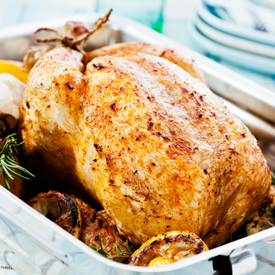
Roast Chicken
A roast chicken is one of those easy-but-great meals, perfect for the cooler season: the oven does all the work, but when you bring that beautifully golden chicken to the table on a platter, you’ll feel like you did something amazing. Plus, you can use the leftovers for lots of great lunchbox-filling salads, wraps, and soups—we’ll show you how!
Ingredients
- 1 whole roaster chicken
- 1 teaspoon salt
- 1⁄4 teaspoon black pepper
- 1 lemon
Directions
- Wash your hands with soap and water, then gather all ingredients and put them on a clean counter. Turn the oven on and set it to 450 degrees.
- Take the chicken out of its package and remove and throw away the giblets and neck from the chicken cavity (unless there’s someone at home who knows how to do something with them, and yes, this step can be kind of gross). (Safety tip: Always wash your hands with soap and water before and after handling raw chicken.)
- Put the roasting rack on the baking sheet, then put the chicken on the roasting rack and rub it with the salt and pepper. Put the lemon quarters in the cavities, which are the openings in the front and back of the chicken.
- Carefully place the baking sheet in the oven (you might need your adult for this).
- After 1 hour and 10 minutes have passed, take the chicken out of the oven to test for doneness (ask your adult for help with this). If you are using a meat thermometer, stick the sharp part deep into the inner thigh: the chicken is done when the thermometer reads 165 degrees. If you do not have a meat thermometer, you can tell when the chicken is done with one of these tests: Poke the thigh with a sharp knife and look at the juice that runs out; it should be clear (not pink); Or wiggle the leg, which should move easily. If it’s not done, put it back in the oven and test it again after 15 minutes. (Ask an adult to help you with this part.)
- Let the chicken rest on a cutting board for 15 to 20 minutes before asking your adult to carve it.
Notes
- Hungarian: Sprinkle the chicken with 2 teaspoons Hungarian paprika before roasting.
- Italian: Add 1 sprig fresh rosemary and 2 chopped garlic cloves to the cavity before roasting.
- Fruity: Instead of filling the cavity with a lemon, use a cut-up orange, apple, or onion.
- Herby: Add a combination of herbs (thyme, rosemary, parsley, marjoram, and/or sage) to the cavity before roasting.
Did you know? The technical name for the wishbone is the furcula, which means “little fork” in Latin. It’s formed by the joining of the two clavicles (collar bones) and helps make the bird’s skeleton strong enough for flying.
Recipes provided by USDA MyPlate Kids Partner Group member: Chop Chop
Roasted Chicken









